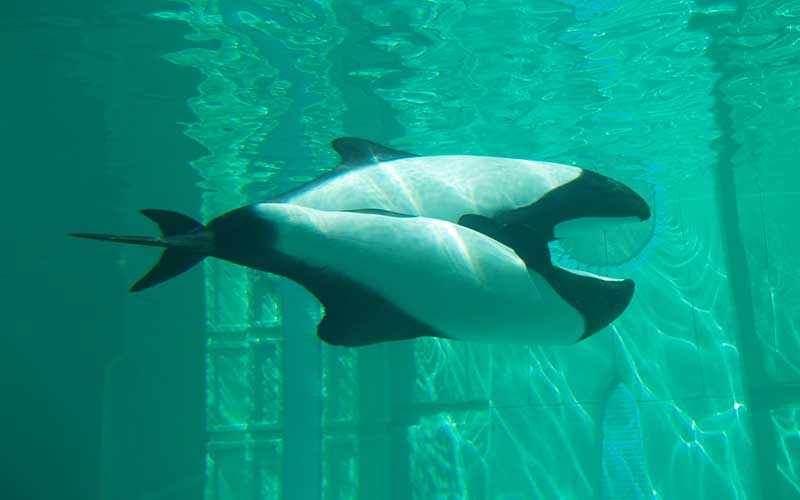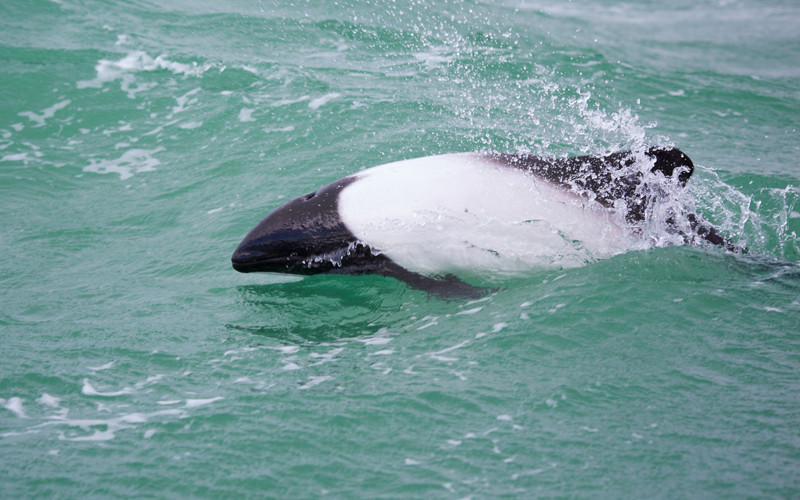Commerson’s Dolphin Facts
(Cephalorhynchus commersonii)
INFORMATION AND CHARACTERISTICS.
The Commerson’s dolphin is also known as the skunk dolphin or panda dolphin. It is one of the four members of the genus Cephalorhynchus, a group of dolphins very attractive because of the coloring patterns of their skin.
It was named “Commerson” in honor of Philibert Commerson, the French naturalist who described this dolphin for the first time. There are two subspecies, separated by about 8,500 kilometers. One native to South America and the other only inhabits the Kerguelen Islands.
Order: Cetacea
Family: Delphinidae
Genus: Cephalorhynchus
HOW DO THEY LOOK? PHYSICAL CHARACTERISTICS.
It is very easy to identify a Commerson’s dolphin because of its unique characteristics.
Weight and size.
It has a small and a sturdy body which gives it a unique appearance. In average, an adult has a weight of 23-65 kilograms, and a length of 1.3-1.5 meters.
Morphology.
With an appearance small and fat, this cetacean could resemble a porpoise without considering its color pattern. The shape of its body is more conical than fusiform in the front, but it has a large head, round, with the forehead tilted and devoid of a visible “beak.” The dorsal fin is small and rounded. It has two small flippers, sometimes with grooves.
Skin Coloration.
The black and white colors predominate on its skin, but the pattern is variable depending on the geographic region where the dolphin inhabits. The black is present in all the head passing the blowhole and reaching the pectoral flippers. A black band also joins the flippers, and the black color extends again from the dorsal fin to the back covering the tail but not the sides, just in the upper part. The lower jaw and the belly are completely white except for a black oval or heart-shaped spot around the genital slits.
Distinctive characteristics.
The colors of its skin are the most outstanding features of their body, enough to differentiate them from other dolphins. Also, the shape of its body is different from most dolphins.
WHERE DO THEY LIVE? DISTRIBUTION AND HABITAT.
It inhabits a particular area that includes waters of the South West Atlantic Ocean owned by Argentina and Chile. It is present near the coasts of these countries and around the Falkland Islands, the Strait of Magellan, Cape Horn, Tierra del Fuego, and near the Patagonia. A small population dwells in the waters around the Kerguelen Islands in the Southern Indian Ocean. They usually do not inhabit beyond the latitude 55° south.
The Commerson’s dolphin lives in waters close to shallow coasts with temperatures ranging from 1° C to 16° Celsius. It is common to see it in ports, bays, estuaries and even at the mouths of rivers, in waters with less than 100 meters deep. For this cetacean, it is not a problem to swim in tight bodies of water or high currents.
WHAT DO THEY EAT? DIET AND EATING HABITS.
The diet of the Commerson’s dolphin is composed of benthic and pelagic prey. Hake, sardines, silversides, anchovies, crustaceans, cephalopods, marine worms and occasionally seaweed are present on the menu. In the stomachs of South American dolphins, researchers found the remains of 25 different species. 22.5 percent were remnants of Mysid Shrimp (Order Mysida), 20.4 percent were three species of fish, 14.1 were of squid, and the remaining percentage represented algae and benthic invertebrates.
It hunts alone or accompanied on high seas, grasslands of algae and structures made by man. The remains of benthic animals suggest that it could be an opportunistic hunter.

Commerson’s dolphin Cephalorhynchus commersonii.
HOW DO THEY BEHAVE? BEHAVIOR
The Commerson’s dolphin feeds and reproduces in groups, but it forms small pods. It also associates with porpoises and other species of dolphins given the social versatility this species has. A pod can be as small as 1-3 members, or as large as 100 or more individuals.
They swim quickly reaching speeds of 11 to 13 kilometers per hour.
They like to ride the waves of the sea, swim upside down, spin underwater and make short jumps, they have even been seen breaking the waves near the seashore. It has a curious and playful behavior which even use garbage as toy although it has also been seen pushing objects away.
HOW DO THEY REPRODUCE? MATING AND REPRODUCTION.
The polygamous Commerson’s dolphin mates between September and February and the mothers give birth to one offspring after a gestation period of 10-12 months, in December. Males and females copulate belly with a belly in an upright position.
A calf is born with gray skin and measures less than 1 meter in length (0.5 to 0.75 meters) and weighing 4.5 to 7.3 kilograms. At two months of age, it begins to eat solid foods with the help of its mother and, after nine months is weaned.
The male reaches sexual maturity between six and nine years old while the female is mature at the age of 5-9 years.
WHAT IS THEIR CONSERVATION STATUS? THREATS AND CONSERVATION.
The color pattern of the Commerson’s dolphin confuses most of its predators, that is, it functions as camouflage.
Conservation Status: “Data Deficient.”
The International Union for the Conservation of Nature, on its Red List, has classified this species as “Data Deficient” which does not mean that this species is out of danger, but that this organization does not have enough information to assess its conservation status.
Their greatest threats are human activities, which contribute to the reduction of their populations and affect their natural habitat.
The specific anthropogenic activities that affect this dolphin are:
– Direct catch (to obtain its meat and oil).
– Bycatch.
– Habitat Contamination.
– Tourism that disturbs its habitat.
This dolphin is in Appendix II of CITES, which houses potentially endangered species whose catch require regulation. There are still no specific conservation efforts, and detailed research on the causes of incidental mortality is still needed.
References
Jefferson, Webber, Pitman. Marine Mammals of the World: A Comprehensive Guide to Their Identification. Academic Press, 2015. Page 309.
https://en.wikipedia.org/wiki/Commerson%27s_dolphin
http://www.iucnredlist.org/details/4159/0
https://www.sib.gov.ar/ficha/ANIMALIA*cephalorhynchus*commersonii

